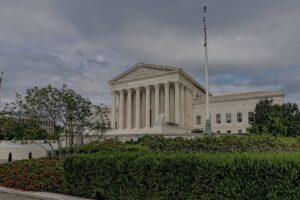Recently, the Bureau of Consumer Financial Protection (the “Bureau” or the “CFPB”) survived an appropriations-based challenge to its funding mechanism. In a challenge brought by Consumer Financial Services of America based on the appropriations clause of the Constitution,[1] the Fifth Circuit in 2022 had invalidated that mechanism, but in a decision issued on May 16, 2024, the U.S. Supreme Court reversed.[2]
No stranger to existential constitutional challenges, the Bureau fared less well in the 2016 Supreme Court decision in the Seila Law case. There, a divided Court held that the Bureau was unconstitutionally constituted. Writing for the majority on the structural issue, Chief Justice Roberts concluded that the combination of a single agency director and termination only for “inefficiency, neglect of duty, or malfeasance” violated Article II of the U.S. Constitution.[3] Although the Constitution says nothing about removal of executive officials, the majority reasoned that presidents cannot discharge the duty to “take care” unless they have the ability to remove appointees for any reason or none. The requirement of removal for cause “clashe[d] with constitutional structure by concentrating power in a unilateral actor insulated from Presidential control.”[4]
Background
In the omnibus 2010 Dodd-Frank legislation, Congress addressed by problem of weak consumer financial protection at the federal level by relieving the federal prudential banking regulators of jurisdiction over federal consumer financial protection laws and transferring authority for administering those laws to the CFPB, then newly created as an independent bureau within the Federal Reserve System to regulate consumer financial products and services. That regulation included not just the authority to promulgate its own rules—covering the entire consumer financial services market and all consumer financial services providers—but also the power to enforce certain rules issued by the Federal Trade Commission (including rules regarding telemarketing sales and cooling-off periods for sales made at homes); to implement Dodd-Frank’s prohibition on unfair, deceptive, and abusive acts and practices in consumer financial services; and to supervise certain nonbank firms offering consumer financial products and services (including authority to examine and require reports from entities including mortgage bankers, brokers, and servicers; private student lenders; payday lenders; “larger participants” in the markets for other consumer financial products and services; and other covered entities determined to pose risk to consumers). In addition, the Bureau is empowered to enforce federal consumer financial laws against nonbank entities and enjoys the authority to conduct investigations, issue subpoenas and civil investigative demands, initiate administrative adjudications, assess civil money penalties (as well as seek restitution and disgorgement), and prosecute civil actions in federal court.
Congress also gave the Bureau authority to supervise certain depository institutions that historically had been supervised by other regulators for compliance with consumer financial protections. Specifically, the Bureau is responsible for supervising depository institutions with total assets of over $10 billion, and their affiliates, for compliance with federal consumer financial laws. The Bureau coordinates that supervision with other federal and state bank regulators, who retain supervisory authority over those same entities for safety and soundness, among other things. The CFPB’s supervisory authority encompasses the power to enforce the federal consumer financial laws against these entities.
In an effort to insulate the CFPB from politics on Capitol Hill, Congress exempted the agency from the normal appropriations process. Instead, Congress is left out of the loop, and the Bureau receives its funding from the Federal Reserve, which is itself funded outside the appropriations process through bank assessments. Although the Bureau is an independent agency, it is housed within the Federal Reserve System.[5] Congress allowed the CFPB to demand from the Federal Reserve Board up to 12 percent of the Federal Reserve’s budget to help fund the Bureau’s operations.[6] Interestingly, the Federal Reserve’s budget is, in turn, funded not by direct congressional appropriations but through Reserve Bank operations, including interest on government securities acquired as part of those operations, and by assessments on the banks the Board supervises.[7]
The Appropriations Clause Challenge
The CFPB v. Community Financial Services Association case arose in connection with a challenge to the agency’s Payday Lending rule, which had been promulgated to regulate payday, vehicle title, and certain high-cost installment loans that the Bureau found “unfair” and “abusive.”[8] In addition to administrative law challenges to the rule, the plaintiffs argued that the Bureau’s funding mechanism violates the Appropriations Clause. The district court rejected that claim on summary judgment,[9] but the U.S. Court of Appeals for the Fifth Circuit reversed.[10]
Referring to the Bureau’s “anomalous . . . self-actualizing, perpetual funding mechanism,”[11] the Fifth Circuit held it unconstitutional as it constituted an unprecedented “double insulation” of the Bureau from Congress’s purse strings.[12] In the Fifth Circuit’s view, not only did Congress abdicate its role in the agency’s appropriations process, as the CFPB receives its funds from another agency that is also not subject to regular appropriations, but whereas the Board must normally remit to the Treasury excess or unused funds and thereby remains “tethered” to some form of political accountability, there is no comparable tether for the CFPB, making it essentially unaccountable.[13]
The Supreme Court granted certiorari in February 2023, but extensions of time for brief filings delayed resolution of the case. Ultimately, however, the Court upheld the Dodd-Frank Act’s CFPB funding mechanism.
Authored by Justice Thomas, the majority opinion concluded that “the Constitution’s text, the history against which that text was enacted, and congressional practice immediately following ratification” demonstrate that “appropriations need only identify a source of public funds and authorize the expenditure of those funds for designated purposes to satisfy the Appropriations Clause.”[14] Reviewing pre-Founding English and colonial sources, the Court found that the word “appropriations” would have been understood at the founding simply to mean the legislature’s authorization of expenditures.
Justice Thomas wrote that Bureau’s funding mechanism “fits comfortably within the First Congress’ appropriations practice” as it “authorizes the Bureau to draw public funds from a particular source—‘the combined earnings of the Federal Reserve System’—in an amount not exceeding an inflation-adjusted cap. And it specifies the objects for which the Bureau can use those funds—to ‘pay the expenses of the Bureau in carrying out its duties and responsibilities.’”[15] Finally, the majority concluded, neither the CFPB’s ability to request an amount of funds to be drawn (subject to a cap) nor the fact that the Bureau’s appropriation is not time-limited was material to the funding mechanism’s constitutionality. Justice Kagan wrote a concurring opinion joined by three other Justices,[16] and Justice Jackson authored a separate concurrence.[17]
Justice Alito, joined by Justice Gorsuch in dissent, took the majority to task for turning the Appropriations Clause “into a minor vestige.”[18] They would have held that the Appropriations Clause “imposes on Congress an important duty that it cannot sign away”[19] without undermining the separation of powers.
Unexpected by many, the Supreme Court’s decision will likely affect certain lower court challenges to CFPB rules on credit card late fees[20] and small business lending data reporting,[21] which had been stayed in reliance on the Fifth Circuit’s invalidation of the funding mechanism. Whether those rules, like the payday lending rule at issue in the Community Financial Services of America litigation, are upheld will have to await decisions on their respective merits.
U.S. Const. art. I, § 9, cl. 7. ↑
Cmty. Fin. Servs. Ass’n of Am. v. CFPB, 51 F.4th 616 (5th Cir. 2022), rev’d, 2024 U.S. LEXIS 2169 (May 16, 2024). ↑
The majority’s constitutional analysis was grounded in the “take care” clause of Article II, which vests “[t]he executive Power . . . in a President” and commands the president to “take Care that the Laws be faithfully executed.” U.S. Const. art. II, § 1, cl. 1; id. art. II, § 3, cl. 1. ↑
Seila Law LLC v. Consumer Fin. Prot. Bureau, 140 S. Ct. 2183, 2192 (2020). ↑
12 U.S.C. § 5491(a). ↑
12 U.S.C. § 5497(a)(1)-(2). ↑
See, e.g., Seila Law, 140 S. Ct. at 2194. ↑
See Bureau of Consumer Financial Protection, Payday, Vehicle Title, and Certain High-Cost Installment Loans, 82 Fed. Reg. 54,472 (Nov. 17, 2017), amended, 84 Fed. Reg. 4252 (Feb. 14, 2019), 85 Fed. Reg. 41,905 (July 13, 2020), 85 Fed. Reg. 44,382 (July 22, 2020) (codified at 12 C.F.R. § 1041.1 et seq.). ↑
Cmty. Fin. Servs. Ass’n of Am. v. CFPB, 558 F. Supp. 3d 350 (W.D. Tex. 2021). ↑
Cmty. Fin. Servs. Ass’n of Am. v. CFPB, 51 F.4th 616 (5th Cir. 2022), rev’d, 2024 U.S. LEXIS 2169 (May 16, 2024). ↑
51 F.4th at 638. This was not the first ominous language foreshadowing the holding on the funding mechanism. The Fifth Circuit’s opinion began as follows:
“An elective despotism was not the government we fought for; but one which should not only be founded on free principles, but in which the powers of government should be so divided and balanced . . . , as that no one could transcend their legal limits, without being effectually checked and restrained by the others.” The Federalist No. 48 (J. Madison) (quoting Thomas Jefferson’s Notes on the State of Virginia (1781)). In particular, as George Mason put it in Philadelphia in 1787, “[t]he purse & the sword ought never to get into the same hands.” 1 The Records of the Federal Convention of 1787, at 139–40 (M. Farrand ed. 1937). These foundational precepts of the American system of government animate the Plaintiffs’ claims in this action. They also compel our decision today.
51 F.4th at 623. ↑
Id. ↑
Id. at 639. “Congress cut that tether for the Bureau, such that the Treasury will never regain one red cent of the funds unilaterally drawn by the Bureau.” Id. ↑
Consumer Fin. Prot. Bureau v. Cmty. Fin. Servs. Assn of Am., 2024 U.S. LEXIS 2169 at *14 (May 16, 2024). ↑
Id. at *27–*28. ↑
Id. at *38–*44 (Kagan, J., with Sotomayor, Kavanaugh & Barrett, JJ., concurring). ↑
Id. at *44 (Jackson, J., concurring). ↑
Id. at *48 (Alito, J., with Gorsuch, J., dissenting). ↑
Id. at *47. ↑
See Chamber of Com. of the U.S. v. Consumer Fin. Prot. Bureau, 2024 U.S. Dist. LEXIS 85078 (N.D. Tex. May 10, 2024). ↑
See Texas Bankers Ass’n v. Consumer Fin. Prot. Bureau, 2023 U.S. Dist. LEXIS 134913 (N.D. Tex. July 31, 2023). ↑

















